The closing of the Johns Hopkins Hospital School of Nursing in 1973 marked the start of a painful period of shattered hopes and uncertainty. Ultimately, success would be bound to the traits that define the Johns Hopkins nurse of every generation: leadership, resilience, and determination.
By Christine Rowett and Sue De Pasquale
Photos Courtesy of The Alan Mason Chesney Medical Archives
Graduation day, June 16, 1973, dawned seasonably warm. Despite the heat, the 41 nursing students in the Class of ’73 all sported long-sleeved white nurses’ uniforms covered by long white aprons as they processed into Turner Auditorium. The outfits were replicas of the uniforms worn by the very first graduating class of 1891—replicas these students had spent weeks creating, with the help of alumni, to mark this historic occasion: the closing of the Johns Hopkins Hospital School of Nursing.
“We felt the weight of it and the finality of it and the sadness of it,” recalls Cathy Novak ’73. “We didn’t want it to be a funeral, but we wanted to honor the school and its traditions.”
“There was definitely sadness,” agrees Sue Appling ’73. “Everyone was crying onstage as we sang the school song.”
What would the closing of the diploma program mean for the future of nursing education at Johns Hopkins? Would nursing education at Johns Hopkins ever gain the financial independence and the educational freedom that its leaders had envisioned since the hospital-based school’s very founding?
These were the questions that Johns Hopkins administrators and nursing school alumnae and students were grappling with that sunny June of 1973, even as the members of the last graduating class posed for photographs and drifted off to celebratory parties.
There were no easy answers, no quick solutions. In fact, the ensuing decade would bring a painful period of uncertainty—of false starts and shattered hopes—for nursing education at Johns Hopkins.
Ultimately, however, success would be bound to the very characteristics that define the Johns Hopkins nurse of every generation: leadership, resilience, and determination.
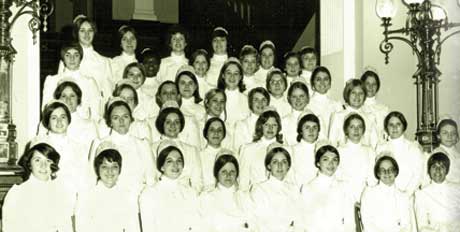
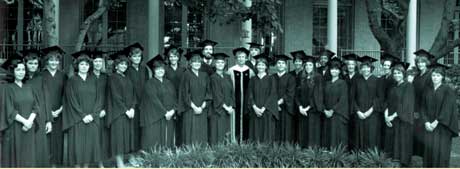
From the very beginning of the Johns Hopkins Hospital Training School for Nurses in the fall of 1889, Hopkins leaders within the hospital and its nursing school envisioned a training program that would be closely aligned with the university.
“In the eyes of the Trustees, nursing the sick is not to be considered a trade but a learned profession,” said the hospital’s first superintendent Henry Hurd, at the inaugural ceremony for the nursing school. “[The school’s] course of study should be more thorough and systematic than that of any other school in the land, as it must inevitably feel the influence of the great University to which the Hospital is so nearly allied.”
In 1915, the nurses’ alumnae association launched the formation of an endowment aimed at advancing nursing education at Hopkins by securing the school’s financial independence. The goal: to raise a whopping $1 million. Throughout the 1920s, the alumnae association discussed with hospital and university leaders the possibility of the nursing school affiliating with the university. “To see our school a part of the Johns Hopkins University has been the ambition and hope of its alumnae,” concluded an alumnae committee in a report issued to the hospital’s trustees in 1928. Though the trustees appointed a committee to look into the issue, progress stalled over the ensuing decades.
When Anna D. Wolf (1915) returned to Baltimore to become the fifth director of the school in 1940, she made it known to students and administrators that she intended to facilitate a university-based school. Wolf had traveled the world, established the first collegiate nursing education program in China at Peking Union Medical College, and laid the groundwork for a baccalaureate program at Cornell. She was determined, yet knew she would face opposition within the hospital and university.
Betty Scher graduated in 1950 and remembers both Wolf’s determination and some of her frustrations.
“When Miss Wolf pushed for a collegiate school of nursing, one of the things they told her was that nurses don’t have the intellectual ability that meets the Hopkins standard,” Scher told author Mame Warren, in an interview for the forthcoming book, Our Shared Legacy. Wolf was not deterred and actually made some progress toward her goal. From 1944 to 1947, she made a baccalaureate degree the educational requirement for admission. In 1948, McCoy College, the evening division of Johns Hopkins University, began awarding a new bachelors of science in nursing degree to graduates
of the hospital school of nursing who had at least two years
of college credit.
Then, in 1965, came a seminal moment for nursing education in the United States. That year marked a new mandate from the American Nurses Association that a nursing diploma would no longer be sufficient for advancement within the field. To move into management positions, future nursing leaders would instead need to be educated at the baccalaureate level. The impact of this decision was keenly felt at Johns Hopkins, where the hospital school of nursing had begun to struggle to maintain its high standards of excellence. Applications to the three-year diploma program dropped sharply, as many potential students began opting for programs that offered baccalaureate degrees. Over the next two decades, hospital-based diploma programs across the country shut their doors.
By 1969, nursing alumnae and Johns Hopkins administrators began publicly discussing the possibility of closing the school. “Diploma education, even our own, has outlived its usefulness and is no longer a benefit to nursing,” wrote Louise Fitzpatrick ’63, in an essay published in the alumnae magazine. In addressing a meeting of the alumnae association, university President Lincoln Gordon acknowledged that “the current school is obsolescent and the question is not whether we should change and create something new—the question is: what, how, when?”
On June 2, 1970, Johns Hopkins Hospital leaders announced that the School of Nursing would close in 1973. Among the reasons cited for the closing: a decline in applications, rising costs of operations, and the need for major renovations of the facilities and equipment. The decision found support from many alumnae, including Scher, president of the nurses’ alumnae association at the time.
“No longer can our school, offering diploma nursing education, attract and conscientiously accept sufficient numbers of superior applicants to merit continuing our quality programs,” she wrote. “Should our school lower its requirements, graduate less-than-the-best nurses? Or should she close her doors and retire with dignity? All of us should completely reject lowering our standards! It is a sad thing that is happening, but it is right.”
Cathy Novak, the president of that last diploma class, remembers interviewing at the school with Betty Cuthbert ’43. Though Novak’s father was concerned about the school closing, Cuthbert made it clear the faculty would uphold their high standards until the very end. “She helped allay my father’s concerns,” recalls Novak. “She acknowledged that they had a standard, and they did not expect to waiver from the standard.”
Novak says she was not disappointed. “I had some very bright, very thoughtful people in that class. They were concerned about nursing, but they were also concerned about the country and the world and they thought big.” While much of the public at that time thought of nurses as “ever present, caring angels,” she says, the reality Novak encountered at Hopkins, even in the diploma school’s waning years, was so much more. “At Hopkins the nurses were outspoken,” she says. “They were educated. They were knowledgeable. They were assertive. They acted.”
In the months leading up to graduation, Novak, Appling, and their classmates struggled to find a fitting way to honor the school they loved so much. When someone mentioned the idea of crafting and wearing replica 1891 uniforms as a nod to the very first class, the concept quickly caught on. “A lot of us felt like it was the right thing to do, but it just felt insurmountable. Many of us didn’t sew,” recalls Novak. “So the alumnae helped and our families helped and our friends helped and our instructors helped. It was the perfect thing to bring cohesion into the school … because things were ending and a lot of traditions were going away. It was a very full time, and it was very bittersweet.”
Even as the Hospital School of Nursing closed its doors that summer of 1973, plans were well under way for a different approach to nursing education. Johns Hopkins leaders had three years earlier unveiled plans for a School of Allied Health Services that would include a nursing education program, as well as a program for “health associates” (essentially physicians’ assistants). The new division would get $3 million in start-up funding from the Robert Wood Johnson Foundation and the first class of nursing majors would enter in September 1975.
For alumnae and others who had championed the concept of creating a university-based program, the new School of Allied Health Services was a step closer to that goal. The two-year program would draw students who had two years of college coursework under their belts. They would graduate with a bachelor of science degree in nursing.
Unfortunately, the school faced challenges from the outset.
Many nursing supporters were dismayed when Malcolm Peterson was named dean of the new School of Health Services. Peterson had been director of the Johns Hopkins Health Services Research and Development Center in the Office of Health Care Programs. Under his leadership, the center had developed two model programs that utilized physicians’ assistants for prepaid health care delivery.
“He was very publicly anti-nursing,” says Martha N. Hill ’64, dean of today’s School of Nursing. Hill says Peterson favored the health associates and health assistants components of the school over nursing education—a sentiment that was reflected by many administrators within the new school. Says Hill, “The School of Health Services was not integrated or respected within the School of Medicine and the university.”
Some alumnae and faculty of the former hospital-based nursing school complained that few, if any, nurse educators had been invited to participate in the planning of the new school.
Though the School of Health Services accepted its first health associate students in the fall of 1973, the nursing program was not ready. The search committee that convened to find a director to implement and lead the Nursing Education Program ultimately tapped Kay Partridge, a faculty member at Hopkins’ School of Hygiene and Public Health and assistant director of nursing at the hospital’s women’s clinic. Ironically, Partridge had also been a member of the search committee for the new director.
“They were down to the wire and that’s when people began to turn to me to do it,” Partridge told author Mame Warren during an interview at Partridge’s Massachusetts home.“I was there. I had most of the basic qualifications. I guess they thought I could do the job.”
By her own admission, Partridge had no experience as a nursing educator. She had earned a master’s in public health from the University of Pittsburgh, then spent several years working in Chile before arriving at Hopkins for a doctorate in public-health nursing. Still, she was directed to prepare a collegiate nursing program that would be ready for students by fall 1975.
“It was hard to hire a faculty, find the students, get a curriculum together, and arrange clinical placements,” Partridge says. She and two faculty members had the task of setting the original curriculum. “It was a massive undertaking,” she recalls, “in not a particularly supportive environment.”
Faced with the school administration’s preference for the health associates program, Partridge questioned the viability of the nascent nursing program. “The placement of nursing education in the School of Health Services was fatally flawed. The choice that most of us faced was whether it was better to do something and get launched and at least have a presence…versus do nothing.”
Partridge made the best of the situation and, in hindsight, is pleased by the high caliber of the faculty and students she and others managed to attract to the school. “In the faculty, you needed somebody who was willing to take a risk, people who were interested in creating rather than maintaining,” she says. “It was a very unusual collection of faculty. The students were even a broader range, and exciting.”
The curriculum offered a departure from traditional nursing programs of the time, which were heavy on bedside care. Instead, the new program focused on training nurse practitioners for community care and public-health nursing, mirroring the changes going on in society and Partridge’s own philosophy.
“Nurses are responsible not only for hands-on care, but for the coordination, the communication,” says Partridge. “They’re the ombudsmen. You talk to families and they can’t penetrate the system. That’s really what nursing is about, to make patient care happen in a way that is productive for the individual and the family.”
Susan Carroll Immelt was a member of that first class that began in September of 1975. Many of her classmates had already completed four years of college and spent some time in the working world, she recalls, and there were four men in the mix. “The people in the class tended to be sort of non-traditional, ex-hippie type people… very interested in alternative health. That was a great experience. We were all friends and in it together,” says Immelt, who today serves on the faculty of Johns Hopkins University School of Nursing.
Students spent a great deal of time working in the hospital. Their clinical time, however, included learning about organizational structure, interpersonal skills, and professional relations with all levels of staff. Immelt and other students worried that they were not learning enough hard science along with their clinical work.
“We did end up going to the provost of the university and complaining about the education we were getting in the program,” Immelt says. “We really didn’t get very much science, certainly not anywhere near what we expect of nursing students now.”
Doubts began to surface within the university’s leadership. In 1977, before the first class graduated, a visiting committee of evaluators was assembled to determine if the nursing program could gain accreditation status from the National League for Nursing (NLN). The accreditation would be vital to the nursing program’s future and its funding prospects.
National leaders in nursing from health care, funding, and education met with staff, observed the program, and consulted with Partridge, who willingly worked closely with the group. “It was one of the ground rules that we were completely open and honest and what was said there, stayed there,” Partridge recalls.
The committee reached some critical conclusions about the embryonic nursing program: The curriculum was unclear and did not live up to the program’s original mission, and financing for the school was unstable. Visiting committee member Doris Roberts wrote that, additionally, the program’s NLN application “needed considerable refinement” to be considered for national accreditation.
Meanwhile, the financial situation at the School of Health Services was bleak. There was a $700,000 deficit in 1977, and the same debt was expected for 1978. Ross Jones was vice president for institutional affairs at the university at the time; he recalls that a reduction in federal funding coincided with the decline of alumni support and confidence in the school.
“It was a very difficult period,” Jones says.
The turmoil reached its peak just weeks after Immelt and other members of that first class of nurses graduated from the School of Health Services in 1977. On June 1, armed with concerns from students, criticism from the visiting committee, and the support of university administrators, Dean Peterson contacted Partridge and requested her resignation.
She recalls being shocked. She was aware of the fledgling program’s deficiencies and growing pains, but believed that with significant funding and university support, the program could evolve into its own self-supporting entity.
Partridge’s dismissal created an uproar among faculty from both the nursing and health associates programs; the groups gave Peterson a vote of no confidence and immediately called for his resignation. Peterson complied in a letter of resignation to university president Steven Muller, who refused to accept it. In the midst of the turmoil, at least two faculty members resigned in support of Partridge.
Before the end of the month, Peterson named Margaret Courtney acting director of the Nursing Education Program. Courtney had been the final director of the Hopkins Hospital School of Nursing when it closed in 1973. She had become coordinator for nursing education at the university’s Evening College and served as director of continuing nursing education at the hospital—positions she would continue to hold.
But Courtney would not have long to lead. Citing the deficit, the lack of an endowment, and rising costs of primary care education, the university voted in January 1978 to close the School of Health Services the following year. “We simply didn’t have the funding to keep it going,” Jones says.
When Commencement Day 1979 arrived, a final class of nursing students, numbering just 15, was the last of the three classes to receive nursing degrees from Hopkins’ short-lived School of Health Services.
Eileen Leahy ’78 remembers how unsettling it was for her and her classmates once news of the program’s demise had been announced. Now a development director for a training center for underemployed women, she has since come to understand and appreciate the university’s decision.
“The selling point had been that we were going to create a new type of nurse—[nurse practitioners],” as well as other midlevel health care providers, she says, “But there were some growing pains. To the university’s credit, they just stopped and said the fit is not right. In the meantime, I think they produced a very high caliber group of people.”
In all, about 70 Hopkins nurses graduated from the School of Health Services. Some went on to medical school. Many others earned master’s degrees. Some, like Leahy, remained connected to the Hopkins community through the nurses’ alumni association, which she led in the 1980s. Others from the School of Health Services grew disconnected from Hopkins, feeling neither part of the past nor the future of Hopkins nursing.
“When people talk about the history of Hopkins nursing, they leave us out,” Leahy says. “We’re not a big piece of it, but we were a bridge. To ignore that bridge between the diploma program and the university is to deny a critical link in our history.”
Ultimately, the closing of the School of Health Services opened the door for the realization of a dream—a dream that had been tightly held by nursing school leaders and alumni for close to a century.
In September 1984, the Johns Hopkins University School of Nursing opened its doors, with Dean Carol Gray at the helm. The entering class had 33 students.
Gray had been involved in conducting a feasibility study for a free-standing nursing school within Johns Hopkins University and later helped create the Consortium for Nursing Education comprised of three Baltimore hospitals that had closed their diploma schools of nursing: Johns Hopkins Hospital, Sinai Hospital, and the Church Home and Hospital. The consortium promised financial and administrative support for the school.
“The School of Nursing would not have made it if not for that alliance,” says Ross Jones.
A major financial boost also came from the nurses’ alumnae association, in the form of a $1 million endowment (the culmination of the effort launched in 1915) that established the M. Adelaide Nutting Chair.
Many also credit Robert Heyssel for making the school a reality. Heyssel became president of Johns Hopkins Hospital in 1982, and served as president and CEO of the Health System from 1986 to 1992.
“He came to understand that you cannot have a credible, competent, academic center with a top hospital if you don’t have a top nursing school,” says Martha Hill. “He got the idea and he had the power and the leverage.”
Hill joined the faculty of the new School of Nursing as soon as it opened and became dean more than three years ago after serving as interim dean for a year. From her office on the fifth floor of the Anne M. Pinkard building overlooking Wolfe Street, she gazes out her window to Hopkins Hospital across the street. She is keenly aware of her responsibility to uphold the high expectations of Johns Hopkins University. At the same time she is eager to expand the scope of the university’s youngest academic division.
Today the Johns Hopkins University School of Nursing, whose nursing graduate program has been ranked among the nation’s top nursing schools by U.S. News and World Report, has more than 600 students and 117 faculty members (including full- and part-time). The school, offers baccalaureate, master’s, and doctoral programs, plus post-masters, graduate certificate, and post-doctoral options of study. The program with the largest enrollment is baccalaureate, offering traditional and accelerated options for both first and second degree candidates.
“For almost a century, Hopkins nurses wanted a university school of nursing,” Hill says. “And 20 years ago, those nurses reached their goal. Today we have an outstanding school that has the potential for further development and growth. The long-term outlook is extremely exciting.”
Special thanks to Mame Warren whose research and interviews proved invaluable to the reporting of this article.
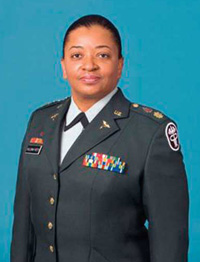 From the Front: Hopkins Nurses in Uniform
From the Front: Hopkins Nurses in Uniform Faculty News
Faculty News Have a Seat, Support a Nurse
Have a Seat, Support a Nurse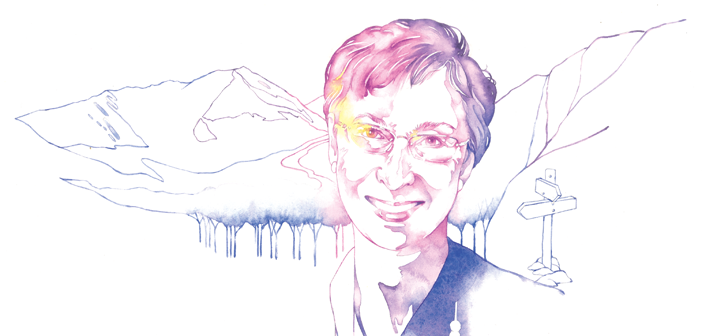 Other Lives: The Hopkins CNOs
Other Lives: The Hopkins CNOs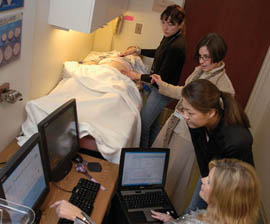 From Digital Assistants to the First Noelle: New Technology Aids Learning
From Digital Assistants to the First Noelle: New Technology Aids Learning







